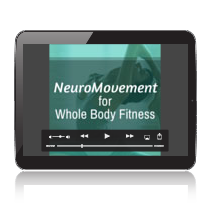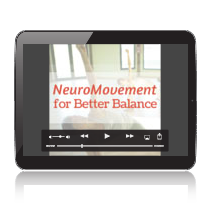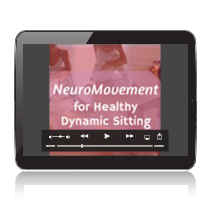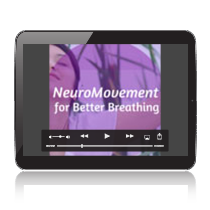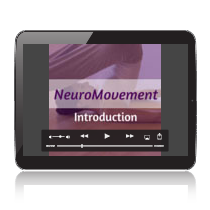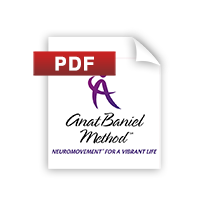Project Description
NeuroMovement® for Whole Brain and Body Fitness
by Anat Baniel
This section contains protected content. Please click below to purchase access.

Have you already purchased access to this content? Please log in here.
“Anat Baniel has evolved to a point few can match, let alone surpass.”
~ Dr. Moshé Feldenkrais
NeuroMovement for Whole Body Fitness is the foundational program for all other NeuroMovement programs.
This program focuses on different areas of the body to ensure sufficient connections in the brain, connections that allow it to successfully organize the basic and more complex movements of the body.
Each movement lesson will help map the areas of focus in the brain, and also form new connections and relationships between different parts of the body. This results in greater flexibility, strength, dexterity and ease of movement.
You will experience the remarkable capacity of your brain to change and transform your life for the better – physically, emotionally, and cognitively. Begin experiencing immediate changes, no matter your age or condition, through gentle, safe, and pleasurable NeuroMovement lessons.
This section contains protected content. Please click below to purchase access.

Have you already purchased access to this content? Please log in here.
“Anat Baniel has developed powerful, practical strategies for improving your abilities and building a better, stronger brain that are supported by the neuroscience of brain plasticity.”
~ Michael Merzenich, PhD, Neuroscientist, American Academy of Sciences
Good balance gives us great freedom in movement. It lets us feel safe and free to venture out into the world; to try new things and to move swiftly and powerfully.
As so many adults suffer compromised balance in their movement, balance problems are among the most common reasons that older adults seek help from a doctor and are a major cause in falls. In 2008, an estimated 14.8 percent of American adults (33.4 million) had some form of balance problem.
And it is not only a challenge for the aging population. Research done in NASA has shown that people in their 20’s already begin to show signs of diminished balance.
Balance is a BIG deal. Our structure is such that our body is built to almost fall, all the time we are upright. We are built with a narrow base, a high center of gravity, and a heavy head at the top.
The good news about this structure is that it makes initiating movement very easy, and allows great freedom to move in all directions. On the other hand, the brain has to constantly make sure we don’t fall.
It takes a healthy child’s brain six years to figure out how to stand safely on one leg for 10 seconds, and how to hop on one leg for 20 feet. This child will continue to improve his or her ability to balance, while doing increasingly more complex activities for years to come.
How come so many people, including young people, begin showing deterioration in their balance skills?
Children are constantly moving with their brains, negotiating the gravitational field continuously, but adults sit for long hours at a time, starving their brain of the need to figure out how to not fall. And even with some popular fitness programs, the physical activity does not require the brain to negotiate balance. For example: using stationary bikes, lifting weights while strapped into a machine, or doing exercise routines that have a limited number of movement variations, all have a sedentary balance posture.
Is it unavoidable for people as they age to become rigid and increasingly more limited in their movement as they widen their stance, attempting to not lose balance?
The answer is a definite NO! The human brain is the most changeable part of our bodies. With the right conditions all symptoms of aging, including deteriorated balance, can reverse themselves.
Balance is the outcome of your brain having the resources and the speed to make sure you do not fall as you move. With NeuroMovement® for Better Balance Program your brain will receive the flow of new information it needs. With this new information your brain will create new connections, and be able to swiftly and effectively stop you from falling as you move.
This section contains protected content. Please click below to purchase access.

Have you already purchased access to this content? Please log in here.
The Human body is built for motion. Movement is key to health and well-being. We are built to move and it is our brain that organizes all of our movements. But movement is also the key to healthy sitting, and the ability to easily and swiftly get out of a chair.
Our body has more than 640 named muscles, 206 bones and 360 joints. Our brain has 100 billion neurons, and an estimated trillion glial cells, the significance of which is just beginning to be recognized, with trillions of connections between neurons in the brain, all of which are busy organizing and executing limitless variations of movement.
Interestingly, studies have shown that idle sitting (e.g. sedentary work) is an independent predictor of disease, meaning that daily exercise before or after work, by itself, does not cancel out a day of sitting in front of the computer.
However, it is not the sitting itself that is the problem. It’s the way we sit, the lack of movement, and the reduction in brain activity that is the problem. We need to be able to sit for extended periods of time, and there a way to sit to avoid the many negative consequences resulting from long hours of sitting.
This section contains protected content. Please click below to purchase access.

Have you already purchased access to this content? Please log in here.
Chronic obstructive pulmonary disease is the 4th leading cause of death in the United States. And even when someone isn’t suffering from a breathing related illness, many people feel that they would like to breathe better.
With NeuroMovement for Healthy Breathing, you will learn different ways to breathe well. You will gain the freedom to change how you breathe as you change what you do, your level of exertion, your emotional states, what you feel and what you think.
How come so many of us do not breathe nearly as well, or as fully as our bodies are built to do?
The reasons can be many. Trauma, chronic anxiety, or stress due to long period of required focus and performance. For example, a child sitting for long hours in school, having to listen and follow the teacher’s instruction, or long hours spent doing homework, can affect the quality of our breath.
In addition, the movement of breathing, which is activated automatically by the brain, shares skeletal structures and muscles that are involved in many of our voluntary movements. For example our ribs, spine, sternum, shoulder blades, the muscles of the back, chest, and neck are all affected by our breath.
With NeuroMovement for Healthy Breathing, we address the voluntary muscles and skeletal structures associated with breathing to help map them more fully in the brain and remove limitations so that better breathing can take place.
With greater freedom of movement, the automatic mechanisms of breathing in the brain can take over and respond much more efficiently to the demands of daily life.
This section contains protected content. Please click below to purchase access.

Have you already purchased access to this content? Please log in here.
In this introductory video you will see and learn some of the underlying concepts of NeuroMovement that you can begin using in your daily life right away.
You will also experience, through short movement lessons, the power of your brain to change you and your body for the better.
This section contains protected content. Please click below to purchase access.

Have you already purchased access to this content? Please log in here.
Did you know that when you want to become more flexible in your movements, it’s your brain that needs to change first?
And when you want to get stronger in your body, it is also your brain that needs to change, not just the muscles.
And if you want to think more clearly, or change a habitual emotional pattern, it is also your brain that needs to change.
NeuroMovement gives your brain the information it needs to change, so that you can overcome pain, become stronger, more flexible and more successful on all levels. This 9 page PDF will guide you through the theory and practice of the Anat Baniel Method and NeuroMovement.
Anat Baniel

Anat Baniel, founder of the Anat Baniel Method, is the author Move Into Life: The Nine Essentials for Lifelong Vitality and the highly acclaimed Kids Beyond Limits. Anat trained as a clinical psychologist, dancer, and was a close professional associate of Dr. Moshe Feldenkrais. Anat’s work is at the forefront of the emerging brain plasticity field. Her innovative, scientifically based methods provide concrete, powerful and easy to use tools that help change people’s brains and lives for the better. Visit her website at www.AnatBanielMethod.com.
Anat Baniel’s Appearances on The Aware Show
Anat Baniel on KPFK
Anat Baniel Quotes
“Movement is the language of the brain.”
“Awareness means the ability to observe yourself and know what it is that you are observing. It is the highest-level, most evolved capacity of the human brain.”
“A radiant body expresses spontaneous, authentic confidence, freedom, love, and happiness. It’s a body that expresses vitality, intelligence, and creativity. It’s you being strong, flexible, and full of life.”
Anat Baniel Testimonials
“Anat Baniel has evolved to a point few can match, let alone surpass.“
“Anat Baniel has developed powerful, practical strategies for improving your abilities and building a better, stronger brain that are supported by the neuroscience of brain plasticity.“

